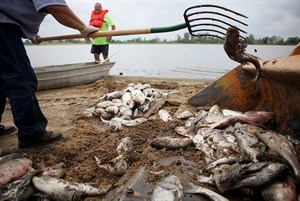
Buchanan County, Mo., employees Ron Martin prepares to go back out onto Lake Contrary Thursday afternoon Aug. 9, 2012, in his jon boat to pick up more dead fish while Shane Hartman tosses what he collected into a front end loader. Low water levels and extreme heat caused a sizable fish kill in the Oxbow lake that the Missouri Department of Conservation estimates to be about 20,000 mostly invasive Asian Carp. (AP Photo/The St. Joseph News-Press, Eric Keith)
August 10, 2012 - 9:32 AM
ST. LOUIS - The federal government on Friday slashed its expectations for U.S. corn and soybean production for the second month in a row as the worst drought in decades continues punishing key farm states.
The U.S. Agriculture Department cut its projected U.S. corn production to 10.8 billion bushels, down 17 per cent from its forecast last month of nearly 13 billion bushels and 13 per cent lower than last year. That also would be the lowest production since 2006.
The USDA, in its monthly World Agricultural Supply and Demand Estimates report, now expects corn growers to average 123.4 bushels per acre, down 24 bushels from last year in what would be the lowest average yield in 17 years.
Soybean production is now forecast at 2.69 billion bushels, a 12 per cent decline from last year and well off the 3.05 billion bushels the USDA had expected last month. Expected yields on average of 36.1 bushels per acre would be the lowest since 2003.
Friday's revised outlook comes months after corn farmers expected this to be a record year when they planted, sowing 96.4 million acres — the most since 1937. But the USDA now forecasts the area to be harvested to be 87.4 million acres.
The USDA had somewhat foreshadowed the newly lowered expectations, noting earlier this week that exactly half of the nation's corn crop was rated poor to very poor, up 2 percentage points from the previous week and creeping closer to the peak of 53 per cent of 24 years ago. Some 39 per cent of soybeans now fall under those two categories, rising 2 percentage points for the second straight week and eclipsing the 1988 benchmark of 37 per cent.
The nation's rangeland and pastures are faring even worse, with roughly three-fifths rated to be in poor to very poor shape — the largest area thus affected in 18 years.
Friday's USDA report amplified the troubling picture already painted a day earlier, when the latest weekly U.S. Drought Monitor map showed that the drought conditions in Plains states where production of corn and soybeans is key continue to worsen. That update showed that the expanse still gripped by extreme or exceptional drought — the two worst classifications — rose to 24.14 per cent, up nearly 2 percentage points from the previous week.
That's because key farm states didn't get as much benefit from rains as elsewhere on the heels of temperatures in July that federal scientists said were so high they broke a record set during the Dust Bowl of the 1930s. The National Oceanic and Atmospheric Administration reported Wednesday that this year's first seven months were the warmest on record for the nation while the stretch from August 2011 through July this year was the balmiest 12-month period on record.
According to the latest Drought Monitor map, growers in Iowa — the nation's biggest corn and soybean producer — saw their conditions further deteriorate, with the amount of that state in extreme or exceptional drought more than doubling from 30.74 per cent last week to 69.14 per cent now. In neighbouring Nebraska, the expanse of land considered in the two worst drought categories rose to 91.2 per cent, up 8 percentage points. The amount of Kansas in exceptional drought also more than doubled, up to 38.58 per cent from 17.45 per cent, while extreme or exceptional drought in Illinois spiked roughly 10 percentage points, to 81.18 per cent.
Such dry conditions have factored into a sharp rise in global food prices after three months of decline, the U.N.'s Rome-based Food and Agriculture Organization said in its monthly price report Thursday. The FAO said its overall food price index climbed 6 percentage points in July, although it was well below the peak reached in February 2011.
The FAO's index, considered a global benchmark used to track market volatility and price trends, measures the monthly price changes for a basket of food items including cereals, oils and fats, meat, dairy products and sugar.
Severe drought punishing the U.S.'s midsection has sent corn prices soaring, and expectations of worsened crop prospects in Russia because of dry weather sent world wheat prices up 19 per cent, according to the FAO, which keeps close tabs on volatile global prices. Spikes in the prices of staple foods have led to riots in some countries in recent years.
The U.S. leads the world in exporting corn, soybeans and wheat, and the surging prices are expected to be felt across the international marketplace, hurting poor food-importing countries, said a study by British charity Oxfam issued on the eve of the U.N. report.
News from © The Associated Press, 2012